I have a 1936 standard that i recently had the transmission rebuilt. The mechanic that rebuilt it told me the transmision was missing a piece but if i double clutched it should be alright. The transmision was s not shifting correctly giving a grinding noise and doesnt slip into gears with grinding eventully i can find the gear . The mechanic that rebuilt it died and i dont remeber the part he told me i was missing. Does anyone have an idea what part i can be missing . And also is it the same transmission a 1937 uses. I hace a 207 1936 chevy standard
!936 Standard trans . is a spur gear trans with no syncronizers , it is hard to shift . a 37 trans. is NOT the same .
Your 1936 Chevy Standard uses the same transmission as my 1935 Standard. If everything is working as it was designed to do, you should have no trouble shifting if you double clutch. The trans is not synchronized so I can't imagine what part could have been omitted that would have made it shift better.
I might have an extra transmission if you can't find your problem.
Mike in Missouri
Many Miles of Happy Motoring
3469 Posts on Old VCCA Chat
thanks to all who replied.. just going to scracth the trans repair going to go with a t5 tranny and a rear end that fits my model
Keep in mind that the bolt pattern for 1933-1936 Chevy Standard Series (5 bolts on a 4-1/4" circle) is very unusual and might be unique to these models. If you wish to keep your original wheels, you might have to re-drill the axles and drums for your "new" rear end. Also, the stock rear springs were not intended to undergo the torque of axle housing rotation during acceleration and braking. This torque is handled by the enclosed drive shaft (torque tube). I don't know if this will be a problem but one thing is sure. The new axle cannot be attached to the springs with the original mounting method. Good luck.
Mike
Many Miles of Happy Motoring
3469 Posts on Old VCCA Chat
Mike is correct the rear suspension was not designed to handle the twisting torque of a modern open driveline differential. One solution is to source a '32 to '36 Master transmission with the synchronized second and third gears. If you find one with a freewheeling attachment ('32 to '33) it can be removed and the tail housing moved up to take its place. We had a friend in the Columbia River Region who had a '36 Standard with a Master transmission in it. It worked well. Our '36 Master Town Sedan shifts well.
Some years back there was a fellow who developed an adapter for the t5 to torque tube which left everything else in place and solved the rear spring and brake problem. But that opens up another draw back to the t5 in that the car can now be driven much faster than the brakes can handle.
If your transmission is 12" long, and interchangeable with the 36 deluxe, the complete trans can be replaced with a 1937 - 47 three speed or 1932 - 47 four speed half ton transmission. I believe your U-joint is riveted together rather than bolted. The T-5 has good passenger car ratios but is 20" long. This web site lists T-5 ratios.
This web site lists T-5 ratios. www.britishv8.org/Articles/Borg-Warner-T5-ID-Tags.htm


